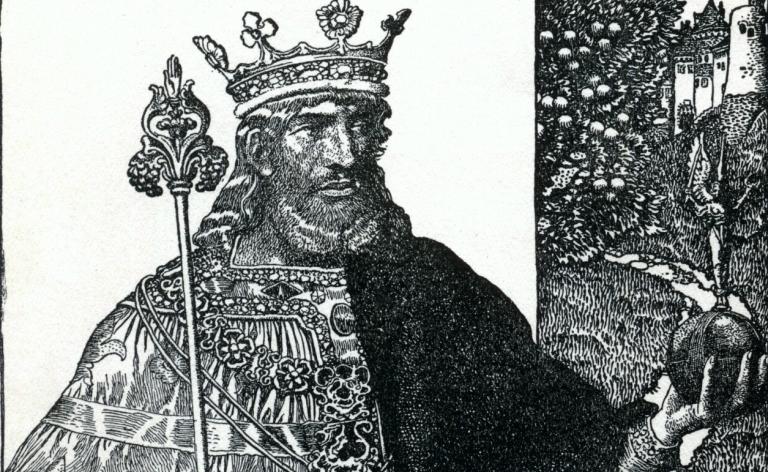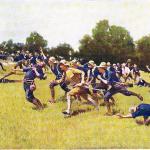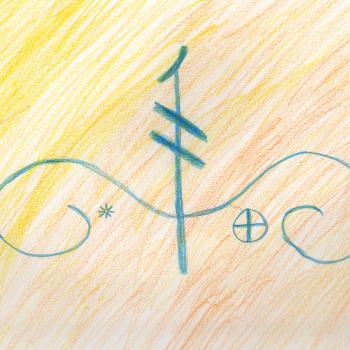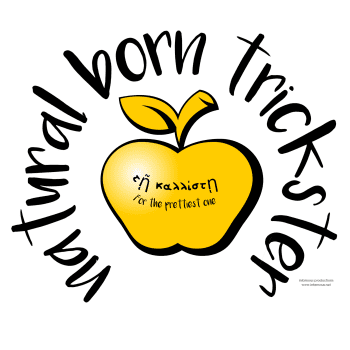Over the this turn of the “Wheel of the Year”, we are investigating and paying respect to eight archetypes of mature, sacred masculinity. The King At Midsummer is the fifth installment in this series.
Context
(If you’ve been reading this series, you can skip this repeating section.)
Men’s mysteries matter. Today, young men are confronted on one hand with reactionary voices who advocate gender roles decades or centuries out of date, and on the other with professional-managerial class “progressive” voice who seem to think the answer to the reactionaries is to eliminate masculinity.
The transition to manhood is dangerous. Men are both more likely than women to be murdered and to commit murder. We’re more likely to be in prison, to be killed on the job, or to commit suicide. We’re less likely to finish high school or earn college degrees.
Boys who fail to make a successful transition to manhood end up at best being a drag on society, and at worst an active threat to people’s lives. And we will not help them make the transition by denying that manhood even exists.
To help young men through the transition, a system of archetypes can be a useful guide. No such system will be complete, of course. What I’m going to talk about in this series of posts is inspired by the book King, Warrior, Magician, Lover by Robert Moore and Douglas Gillette, and also by Robert Bly’s work, but it’s my own thing. Anything smart is probably copied from those others and anything dumb here is probably my own fault.
By considering these archetypes I am not claiming that these roles are unavailable to women or nonbinary folks. Nor am I claiming that this is the only way to be a man. I’m offering some ideas that have helped me come to terms with my own existence as an adult male human being. (And cognizant that that is as a “white” heterosexual American male, though still believing there’s enough universality in the way androgens shape our brains for the exercise to be useful). If they don’t work for you, fine, please tell us your secrets! If you’re not a man and find that they work for you, great!
For each of these archetypes, we’re going to discuss a balanced version, an excess version, and a shadow version.
Visualize us going around a mountain: at the top is the Wild Man and the realm of excess, up where the air is thin. It’s exhilarating but we can’t stay there. At the bottom is the shadow realm of fear. The healthy mature man moves around the middle heights of the mountain, in neither shadow not excess, moving between the archetypes as needed. Over this series, we will visit eight points around the mountain: the Magician, the Healer, the Lover, the Preacher, the King, the Captain, the Warrior, and the Trickster.
The King
Of the archetypes we’re discussing in this series, the King may be the most problematic for us in modern democratic nations to connect to.
Hell, I’m an anarchist. (In a Thoreauvian or Zenarchist sense, not in the sense of “black bloc” ignoramuses smashing windows and throwing rocks or fireworks at people.) I’m against hierarcical power structures. I don’t want to rule anyone and I don’t want any kings ruling over me. I’ve got my issues with the American system of government, but one thing I’m certain the American Revolution did right was dump the divine right of kings and set up a new system without one.
Maybe when we hear “the king”, we think of Mel Brooks’s portrayal of Louis XVI in History of the World, Part I: an immensely privileged man, parasitic on those he rules, smirking as he says “it’s good to be the king”.
But that’s not what the archetypal Sacred King is about.

The King Is A Conduit For Blessings
The sort of King we are speaking of “reigns but does not rule”, as has often been said of the British kings under constitutional monarchy. He does not command, he is not a conqueror. Instead the King is the conduit of blessings for his people. This kingship is all duty and no power, no temporal power at least. The Emperor of Japan, who has been more of a hereditary high priest than a ruler, or the kings of various African peoples, are closer to the core of the thing than the feudal rulers of Europe. The conflation of conquerors with kingship may be a fundamental problem of European culture.
As Lucien Scubla wrote,*
The accumulated ethnographic and historical facts show that kingship is not, in principle, political power. It is an onerous ritual duty which results, more often then not, in the killing of the king. To reign does not mean to govern or to give orders, but to guarantee the order of the world and of the society by observing ritual prescriptions. The king is a sacred figure, but for this very reason he is ‘bound’ by the ritual. Under house arrest and a recluse in his palace, he submits to the same type of restrictions as those who are in a state of impurity…
…
…The king is not the master of the institution but its captive.
Kingship is a central theme of Tolkein’s The Lord of the Rings — the third volume is, after all, The Return Of The King. Aragorn is first seen as a Warrior, acting to fulfill a mission to escort Frodo and his companions; later in the story he leads a great army as a Captain. But it is not his abilities in battle that cause him to be recognized as the king. It is his ability to heal. As the wise woman Ioreth states, “it is said in old lore: The hands of the king are the hands of a healer. And so the rightful king could ever be known.”†
As literary critic Jane Chance explains, “the power of a king resides in his ability to heal, to knit together, to bring peace and fruitfulness to the community, and to return or renew that which has been torn or debilitated.“††
So this is not a physical healing — Aragorn is not setting broken bones or suturing wounds. And it’s not even an individual spiritual healing. Either of those would be the task of the Healer/Shaman.
Instead Aragorn is healing the Black Shadow, the blackness of the soul that the Nazgûl had cast en masse upon the land. Sauron and his servants have injured the order of the world, and it is this that the King heals.
The king is a conduit for blessings: the Chinese character for “king”, 王, is traditionally explained as showing the king as the central pillar connecting heaven, humanity, and earth. He is the man whom others want to be with, just because his company brings joy. Just by association with the King we become healed and empowered and inspired — “Only say the word and I shall be healed.”
In our modern culture, celebrity is a distorted reflection of this sort of kingship, so it’s no wonder that we’ve had so many “royal” entertainers, from Elvis the King, to Duke Ellington, Count Basie, Prince — subverted, perhaps, by Queen. But it is the role of the performer on stage to act as a focus for the energies of the audience, just as the King acts as a focus for the energies of his people.

Next in this series we’ll be discussing the archetype of the Captain. The Captain is the man who leads Warriors (also to be discussed) into battle or other challenge; but the Warriors fight in the name of the King — “for King and Country”, as the cliche goes. Or “We live for the One, we die for the One,” for my fellow Babylon 5 fans.
The King Stands Alone
This role as focus for the energies of his people puts a lot of demands on the King. The crown is heavy.
We began our series at the other side of the year discussing the Magician, who works isolated in his tower, out of sight of others. The King’s isolation is different — he faces outward, he is front and center of his people, while the Magician faces inward. But his isolation is as deep. The King stands at the focus of the parabola of energies, apart from others.
We quoted Scubla above comparing Kingship to house arrest — a very different picture than Brooks’s satire of French royalty.
The archetypes we’re discussing can blend into one another, and all real people and fictional characters manifest more than one of them, so it is instructive to look at the edges between them. An interesting contrast which illustrates the line between the King and the Captain can be found in the first two interations of the Star Trek television series. In the original, Captain Kirk — an archetypal Captain through and through — often leads the landing parties as his crew explores strange new worlds. He is with them leading the way and directly giving orders.
But in The Next Generation, Captain Picard remains on the ship like the King in his palace, while his first officer leads the missions and commands in his name. Picard is more isolated and detached. He occupies not just a command role but a social role: the crew organizes “Captain Picard Day” for the ship’s children. “I’m a role model”, he explains to an admiral.
And not just in the story’s universe — Brandon T. Snider wrote a YA book What Would Captain Picard Do?
Shadow: The Vampire
Where the King energizes us, the vampire drains our energy. The classic vampire Dracula of course, or for my fellow Adventure Time fans, the Lich, who by a mere word can cause our hero to fall. In Lord of the Rings, the “Witch-king of Angmar” (leader of the Nazgul) casts a spiritual “Black Shadow” that drains its victims.
By association with the vampire we become disempowered…and yet he has a hold on us. He makes us into beings like him, as Dracula turns his victims into vampires.
Excess: the God-Emperor
According to Philo, when Caligula became Emperor of Rome, “all the world, from the rising to the setting sun, all the land in short on this side of the Ocean and beyond the Ocean, at which all the Roman people and all Italy rejoiced, and even all the Asiatic and European nations….universal prosperity and happiness…reigned every where, and the absence of all grief and fear, and the daily and nightly exhibitions of joy and festivity throughout every house and throughout the whole people, which lasted continually without any interruption during the first seven months of his reign.”
But in a few months, “he began to indulge in abundance of strong wine and eating of rich dishes, and in the abundant license of insatiable desires and great insolence, and in the unseasonable use of hot baths, and emetics, and then again in winebibbing and drunkenness, and returning gluttony, and in lust after boys and women, and in everything else which tends to destroy both soul and body.” In time, “he no longer chose to remain fettered by the ordinary limits of human nature, but aspired to raise himself above them, and desired to be looked upon as a god.”
Or, again for my fellow Babylon 5 fans, the Centauri Emperor Cartagia, who plans to sacrifice his entire planet in order to elevate himself to godhood.
Applying the archetype of the God-Emperor to the American presidential race of 2024 is left as an exercise for the reader.
The King at Midsummer
Some of our Neopagan traditions speak of the Holly King and Oak King, who do battle at the Winter and Summer solstices. At midsummer the Holly King deposes the Oak King, while at midwinter the Oak King deposed the Holly King; and each is reborn for the next seasonal cycle. “The king is dead, long live the King”; for while the individual king is mortal, the Sacred King represents the order of the world and so must go on.
So take some time this season, as the world blossoms into it fullness, to consider your relationship with this archetype.
Evocation of the King
I evoke and call forth
The Sacred King
I honor and acknowledge
My ability to convey blessings to others
To act as a focus of energies
The social energies, the cosmic energies
I will remember that I am a focus for, not the sole source of,
these sacred energies
I will seek to empower others, never to drain them
I will work to heal my community
I will manifest the Sacred King
And help all those I meet manifest their own sacred selves
So mote it be.
References
On-line references are given by links in the text above. In addition:
* Toklien, J.R.R. The Lord of the Rings, Part Three: The Return of the King. New York: Ballantine Books, 1965. p166
† Chance, Jane. The Lord of the Rings: The Mythology of Power. New York City: Twyane Publishers, 1992, 104; quoted in Calco, Lauren, “The Hands of a Healer:” J.R.R. Tolkien’s Understanding of Kingship, http://ashbrook.org/wp-content/uploads/2012/06/2006-Calco-Hands-of-a-Healer-PDF.pdf
†† Scubla, Lucien. “Sacred King, Sacrificial Victim, Surrogate Victim or Frazer, Hocart, Girard.” In The Character of Kingship, Declan Quigley ed., New York: Berg, 2005, p. 39-40

















